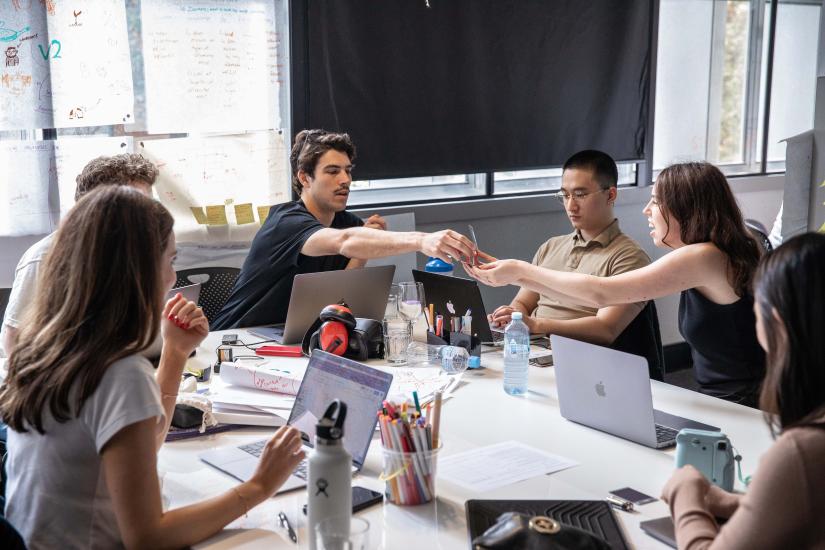Transdisciplinary collaboration can seem difficult to implement, but in practice, it’s necessary to find information asymmetries between disciplines – and spark new solutions.
Transdisciplinary practice at the cutting edge is a final subject in the Bachelor of Creative Intelligence and Innovation (BCII) program. After four years of study, this subject facilitates BCII students to articulate what transdisciplinary (TD) practice is, and why a TD approach is unequivocal in tackling complex problems. This year, students were able to showcase their value as TD practitioners to none other than Google.
As our students prepare to graduate into the workforce, this subject helps them identify their value as individuals and as part of a team. This story was compiled from the contributions of 45 of those talented BCII students.
the value of a td approach
For BCII students, TD collaboration is a reliable approach when faced with complexity.

Photo credit: Maja Baska
For the first years of their studies, BCII students are exposed to a variety of methods to deconstruct complex issues, reframe problems, generate solutions that are targeted to specific user journeys, engage stakeholders and manage project flows in multidisciplinary teams. In this subject, they are given the chance to convince an industry partner about why they should take those same TD approaches to a complex organisational problem they are facing.
“The integration of a TD approach is necessary in unraveling the complex issues of our modern world if we want to create a meaningful impact,” said a group of final year BCII students.
“The value is in being able to acknowledge all aspects of a problem as interconnected elements in a larger, complex system that cannot be isolated.”
Tensions that arise from working with different perspectives on the same problem are invaluable when pushing the boundaries and developing purpose-driven ideas. And, at the crux of a TD team exists a diversity of worldviews and knowledges that foster the tensions and conflict necessary for impactful solution design.
The integration of a TD approach is necessary in unraveling the complex issues of our modern world if we want to create a meaningful impact.
When facilitating the sharing of expertise, skills and diverse knowledges, organisations gain a richer and more holistic understanding of a problem space. Ultimately, this creates more targeted and effective innovations, that lead to lasting and genuine change.
Defining complexity
What makes a problem complex, and not just overcomplicated?
In approaching complicated problems, organisations can follow a blueprint developed from how they might have solved similar problems in the past. This method allows for a tried and tested approach to solving the challenge at hand. And in this instance, a clear process takes team members from the point of the issue to the point of resolution.
You simply cannot solve a problem before understanding its nature, or the acknowledgment of how that one problem sits and interacts with a much larger system.
On the other hand, complex problems envelop a multitude of perspectives and require framing through diverse fields of knowledge and practice. These types of problems can only be intervened in through the embrace of a TD approach.
In these circumstances, an organisation cannot simply adopt an existing blueprint process, as this would fail to appropriately test cause-and-effect assumptions and prevent experimentation.
It goes beyond the need to improve business decisions, strategic resourcing, and efficiency. You simply cannot solve a problem before understanding its nature, or the acknowledgment of how that one problem sits and interacts with a much larger system.
It would be like assuming that pulling on a single thread in a knotted ball of yarn might untangle the ball.
For organisations, it’s becoming more pressing, regardless of their size or industry, to approach problems that are as messy as knotted yarn. And they must consider how to co-create solutions to these internal and broader societal challenges by developing a fusion of expertise with internal and external stakeholders.
“Networked challenges need an adaptable TD lens that move away from a siloed approach to one that encompasses holistic and diverse thinking,” said a group of final year BCII students.

Photo credit: Maja Baska
Practising td
TD practitioners provide unique worldviews and epistemologies to a team dynamic. They value conflicting points of view, alternative learning styles and reflexive practices to propel divergent thinking and generate new ideas.
Combining the core principles of TD, these practitioners can shift the status quo of traditional collaboration to a more agile and flexible way of learning.
Our world is inherently complex – and we know a fixed solution will never remain effective long-term. Instead, we have to learn to move beyond constructing a solution for a specific context, which is destined to fail in a dynamic changing environment, and look toward having frameworks in which we build solutions from foundations that are strong, dynamic, and scalable.
Thank you to the following students for their significant contribution of ideas and insights as seen in the article:
Robert Black, Natalie Kunze, Lachlan Basten, Jess Nguyen, Lauryn Evans, Jasper Wright, Zara Meier, Amelia Bussing, Zalia Lackey, Kiran Surti, Jessica Thomas, Hollie Secomb, Mia Brooks, Chloe Whitford, Olivia Wakeling, Michaela Sullivan, Matthew O’Leary, Kallista Francis, Thomas Pancino, Oscar Casteigt, Rachael Egan, Ben Morrison, Alexander Olivier, Yasmene Placer, Josiah Guanzon, Roland Lo Lu, Patricia Chan, Lucas Olgers, Emma Ramsey, Kate Macken, Jocelyn Tong, Weronika Golos, Imogen Johnson, Alan Kinal, Aspen Morgan, Kimberly Ong, Ashleigh Tan, Gillian Le Mottee, Daniz Abbaspour, Jacob Orr, Kena Mallender, Georgia St Leon, Thomas O’Sullivan, Jaden Kostogiannis, Lachlan Lu, Hannah Martin, Louisa Preston, Travis Radford and Sameer Singh.

